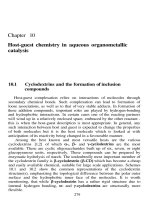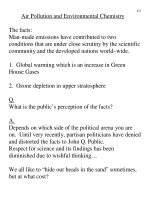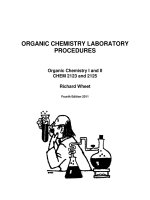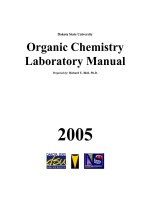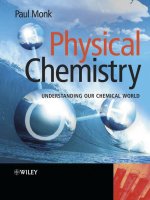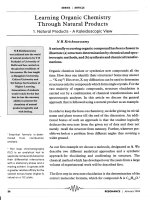CHEMISTRY pdf
Bạn đang xem bản rút gọn của tài liệu. Xem và tải ngay bản đầy đủ của tài liệu tại đây (2.92 MB, 199 trang )
DEGRADABILITY OF POLYMER COMPOSITES FROM
RENEWABLE RESOURCES
A Thesis submitted to the
UNIVERISTY OF PUNE
for the degree of
DOCTOR OF PHILOSOPHY
in
CHEMISTRY
by
JITENDRA KUMAR PANDEY
Polymer Chemistry Division
National Chemical Laboratory
Pune – 411008
India
December 2004
DEDICATED TO AMMA, BAPPA & PROF. RAM GOPAL YADAV
CERTIFICATE
This is to certify that the work incorporated in this thesis entitled “Degradability of Polymer
Composites from Renewable Resources” submitted by Mr. Jitendra Kumar Pandey was
carried out by the candidate under my supervision at the National Chemical Laboratory. Such
material has been obtained from other sources has been duly acknowledged.
Date:
(R.P.Singh)
Research guide
Acknowledgements
I got the opportunity to associate myself with Dr. Raj Pal Singh, senior scientist, Polymer
Chemistry Division, National Chemical Laboratory Pune, as my supervisor. As an
outstanding scientist and teacher he has given me the benefit of his guidance throughout
the course work. I am grateful to him for showing me all the angles of research life.
I also take this opportunity to thank, Head of Polymer Chemistry Division and all
scientific staff, my seniors and colleague from this laboratory, for their unparalleled
company and valuable support.
On this special occasion of my life, I also remember and express my gratitude to
Dr. S.P. Tripathi, Sri Subhash Tiwari, Sri Bhola Singh and all the friends of my father who
always called and encouraged me during difficult time.
I am thankful to my all family members for their courageous assistance during my
research.
It’s my privilege to thank the Director, NCL for giving me this opportunity and
providing all necessary infrastructure and facilities. Financial assistance from CSIR, New
Delhi is greatly acknowledged.
(Jitendra Kumar Pandey)
ABBREVIATIONS
ASTM American Society for Testing and Materials
AESO Acrylated Epoxidized Soybean Oil
CMC Carboxymethylcellulose
CA Cellulose Acetate
CFRP Carbon fiber reinforced composites
CEN Comite Europeen de Normalisation
DMSO Dimethyl sulfoxide
DSC Differential Scanning Calorimetry
DIN Deutsches Institut für Normung Ev
DS Degree of Substitution
CDA-g-PLAs Cellulose diacetate-graft-poly(lactic acid)s
CDA Cellulose Diacetate
DD Degree of Deacetylation
DMA Dynamic Mechanical Analyzer
DFC Direct Fiber Composite
DP Degree of Polymerization
EVSEM Environmental Scanning Electron Microscopy
EP Ethylene -Propylene Co-polymer
EPMA Ethylene-Propylene-Maleic Anhydride co-polymer
EVA Ethylene vinyl aetate copolymer
ESO Epoxidised soybean oil
EVAc Co-polymers of ethylene with vinyl acetate
EVAl Ethylene- vinylalcohol co-polymer
EVAMA EVAc modified with maleic anhydride
ESR Electron Spin Resonance
ESCA Electron Scanning Chemical Analysis
ELO Epoxidized linseed oil
GPTMS 3-glycidoxypropyltrimethoxysilane
GFC Graft Fiber Composite
GC Gas Chromatography
GPC Gel Permission Chromatography [Size Exclusion Chromatography]
GC- MS Gas Chromatography – Mass Spectroscopy
HTA Hydrogenated tallow alkyl
ISO International Organization for Standardization
LDPE Low Density Polyethylene
LC Liquid Chromatography
LSC Liquid Scintillation Counting
MC Methyl Cellulose
MMT Montmorillite
MAH Maleic anhydride
MALDI-TOF Matrix Assisted Laser Desorption Ionization Time-of-flight Mass
Spectrometry
MW Molecular Weight
MBS Methyl Methacrylate -Butadiene-Styrene co-polymer
Na+-MMT Sodium Montmorillite
O-PCL Oligomeric polycaprolactone
OMMT Orgonically modified montmorillite
PCL Poly (ε-caprolactone)
PP-g-MA Polypropylene grafted maleic anhydride
PS Polystyrene
PLA Poly actiacid
PE Polyethylene
PHB Poly (hydroxybutyrate)
PHA Polyhydroxyalkanoates
PBS Poly (butylenes succinate)
PALF Pineapple Leaf Fibre
PCA Plasticized Cellulose Acetate
PS Polystyrene
PHBV Poly(3-hydroxybutyrate-co-3-hydroxyvalerate)
PVOH Polyvinylalcohol
PVA Polyvinylacetate
PP-MAH Polymer functionalized with maleic anhydride.
RH Relative Humidity
SMA Styrene-Maleic Anhydride co-polymer
SEM Scanning Electron Microscopy
TPS Thermo Plastic Starch
TPP Tripolyphosphate
TEM Tunneling Electron Microscopy
TGA Thermal Gravimetric Analysis
UV Ultra violet
VATM Vacuum Assisted Transfer Molding
WVA Water vapor Absorption
WG Waste Gelatin
XRD X-Ray Diffraction
WAXD Wide Angle X-Ray Diffraction
ABSTRACT
ABBREVIATIONS
CHAPTER I:
POLYMER COMPOSITES FROM RENEWABLE RESOURCES
1.1. Introduction
1
1.2. Renewable resources
2
1.3. Importance of renewable resources
2
1.4. Polymers from renewable resources
2
1.5.Degradation of polymeric materials
4
1.5.1. Photodegradation
4
1.5.2. Thermal Degradation
5
1.5.3. Biodegradation
5
1.5.3.1. Degradable Plastic 5
1.5.3.2. Biodegradable Plastic
5
1.6. Miscellaneous
6
1.7. Evaluation methods for degradability. 6
1.8. Polymer composites from renewable resources.
10
1.8.1. Biofiber composite 10
1.8.1.2. Degradability of biofibres
11
1.8.1.3. Composites from cellulose
11
1.8.2. Starch composites
15
1.8.2.1. Composites of starch with synthetic polymers
16
1.8.2.2. Composites of starch with natural polymers
18
1.8.2.3. Composites of starch after chemical modification
19
1.8.2.4. Nanocomposites of starch
20
1.8.2.5. Commercial biodegradable products of starch
21
1.8.3. Composites of PLA
23
1.8.3.1. Composites with natural polymers
23
1.8.3.2. Nanocomposites of PLA
24
1.8.3.3. Commercial degradable products from PLA
25
1.8.4. Poly ( hydroxy alkanoates)
25
1.8.5. Composites from Natural oils
27
1.8.6. Composites from Pectin
28
1.8.7. Composites from Gelatin
29
1.8.8. Composites from Chitosan
30
1.8.9. Soy Plastics
31
1.8.10. Miscellaneous 32
1.9. Conclusions and future trends
34
1.10. References
35
CHAPTER II:
OBJECTIVES AND APPROACHES OF PRESENT
INVESTIGATION
2.1 Objective of the Present work
46
2.2. Approaches
47
2.3. References 48
CHAPTER III:
DEGRADABILITY OF PE, PP AND EP COPOLYMERS UNDER
BIOTIC AND ABIOTIC ENVIRONMENTS
3.1. Introduction
49
3.2. Experimental
49
3.2.1. Materials
49
3.2.2 Preparation of films
50
3.2.3. UV irradiation
50
3.2.4. Viscosity Measurement
50
3.2.5. Incubation in compost
50
3.2.6. Incubation in culture
51
3.2.7. FT-IR Spectroscopy
52
3.2.8. Scanning Electron Microscopy
52
3.3 Results and Discussion
52
3.3.1 Incubation in Compost
52
3.3.2. Variation in viscosity
54
3.3.3. FT-IR Spectroscopy
55
3.3.4 Incubation in culture
60
3.3.5. Morphological aspects
61
3.4. Conclusions
63
3.5. References
64
CHAPTER IV:
DEGRADABILITY OF BIOCOMPOSITES PREPARED FROM
CELLULOSE AND PE, PP , EP COPOLYMERS
4.1 Introduction
66
4.2. Experimental Part
67
4.2.1. Material
67
4.2.2. Preparation of composites
67
4.2.3. Characterization and performance evaluation
68
4.3. Results and discussion
68
4.3.1. Compatibility of fiber and polymer matrix
68
4.3.2. Photodegradation
71
4.3.3. Biodegradation
74
4.3.3.1.Composting
74
4.3.3.2. Culture testing
79
4.3.4 Morphological aspects 81
A. PCL–granular starch blends
85
B. Hydrophobic coating of starch granules and melt blending with
PCL
87
C. Synthesis of PCL-grafted dextran copolymers and use as
compatibilizer in PCL–granular starch blends
88
D. In situ PCL grafting onto starch granules and melt blending with
PCL.
92
4.4. Conclusions
94
4.5. References
95
CHAPTER V:
DEGRADABILITY OF POLYMER COMPOSITES PREPARED
FROM LAYERED SILICATE
5.1. Introduction
98
5.2. Experimental
99
5.2.1. Materials
99
5.2.2. Preparation of nanocomposites and characterization
99
5.2.3. Durability evaluation
100
5.3. Results and discussion
101
5.3.1. Structure of composites
101
5.3.2. Photodegradability of composites
102
5.3.2.1. Photodegradation products
102
5.3.2.2. Effect of DE and LM content on photodegradation
105
5.3.2.3.Effect of modifier on photodegradation
110
5.3.3.Biodegradability of composites
111
5.4. Conclusions
115
5.5 References
117
CHAPTER VI:
DEGRADABILITY OF BIOCOMPOSITES PREPARED FROM
STARCH AND LAYERED SILICATES
6.1 Introduction
118
6.2. Experimental
119
6.2.1. Materials
120
6.2.2. Preparation of nanocomposites 120
6.2.3. Characterization and measurements
120
6.2.3.1. WAXD
120
6.2.3.2. Thermogravimetric Analysis
120
6.2.3.4. Mechanical Properties
121
6.2.3. 4. Water Uptake (WU) 121
6.2.3.5 . FT-IR and Biodegradability in compost.
121
6.3. Results and discussion
121
6.3.1. Structure of nanocomposites
121
6.3.2. Effect of filler dispersion on the material properties
124
6.3.2.1. Mechanical properties
124
6.3.2.2. Moisture resistance
128
6.3.2.3. Thermal properties
129
6.4. Degradability of composites
132
6.5. Conclusions
134
6.6.References
135
CHAPTER VII:
DEGRADABILITY OF BIOCOMPOSITES PREPARED FROM
MODIFIED STARCH AND LAYERED SILICATES
7.1. Introduction
137
7.2 .Experimental
138
7.2.2. Preparation of starch derivatives
138
7.2.2.1. Preparation of starch acetate
139
7.2.2.2 .Preparation of butyryl derivative
139
7.2.3.Preparation of Composites
140
7.2.4. Contact angle
141
7.2.5. Transmission Electronic Microscopy (TEM)
141
7.2.6 .FT-IR, Water Uptake (WU) and degradability
141
7.3. Results and Discussion
141
7.3.1. Characterization 141
7.3.2. Thermal properties
148
7.3.3. Water uptake
150
7.3.4. Contact angle
151
7.3.5. The nanocomposites of butyryl modified starches
152
7.3.6. Biodegradability 155
7.4. Conclusions
159
7.5. References
160
CHAPTER VIII:
SUMMARY AND CONCLUSION
162
LIST OF FIGURES
Figure No. Title Page
No.
Figure 1.1.
Different degradation and stabilization mechanisms. 4
Figure 1.2.
The possible degradation pathways of polymeric material 7
Scheme 1.1
Initiation and propagation of photodegradation in polymers 5
Figure 1.3.
Different Evaluation methods for degradability 9
Figure 1.4.
Structure of cellulose diacetate 13
Figure 1.5.
Structure of both components of starch. 15
Figure 3.1
Compost temperature changes during study 51
Figure 3.2.
Weight loss of samples [A, without irradiation, B, 50 and C 100 h
irradiation respectively]
54
Figure3.3.(a)
Norrish type I (NI I) and Norrish type II (NI II) mechanisms of
photodegradation
56
Figure 3.3 (b) Increase in hydroxyl region during UV irradiation of samples. 57
Figure 3.3. (c)
Increase in carbonyl region during UV irradiation of samples. 57
Figure 3.3. (d)
Rate of formation of carbonyl (a) and hydroxyl (b) group
formation.
58
Figure 3.3 (e).
Formation of ester during photodegradation 58
Figure 3.3. (f) UV irradiated EPF before (a) and after composting (b). 58
Figure 3.3 (g)
Biodegradation mechanisms in polyolefin. 59
Figure 3.4.
100hr irradiated samples of EPF (a), PP (b), EPQ (c), LDPE (d)
and 50 hr irradiated sample of PP (e) and EPF (f) after
composting
62
Figure 4.1
FT-IR spectra of PP after treatment with MAH 69
Figure 4.2.
Esterification in MAH treated PP by cellulose fiber. 70
Figure 4.3.
Peaks for free OH groups in the composites. 70
Figure 4.4.
Hydroxyl bonding in the composites. 71
Figure 4.5. (a)
Changes in carbonyl group region of DFC of PP during
irradiation.
72
Figure 4.5. (b)
Changes in hydroxyl group region of DFC of PP during
irradiation.
73
Figure 4.6. (a)
Changes in carbonyl group region of GFC of PP during 73
irradiation.
Figure 4.6. (b)
Changes in hydroxyl group region of GFC of PP during irradiation 74
Figure 4.7.
Unsaturation variations in DFC of PE composite upon irradiation. 74
Figure 4.8.
Weight loss of unirradiated samples 75
Figure 4.9.
Weight loss of 20 h irradiated samples 75
Figure 4.10.
Weight loss of 50 h irradiated samples 76
Figure 4.11.
Weight loss in 100 h irradiated samples 76
Figure 4.12.
Weight loss of 100 hr UV irradiated DFC and GFC of LDPE after
composting (DFC after 4 months and GFC after 5 months)
77
Figure 4.13.
Weight loss of 100 hr UV irradiated DFC and GFC of EPQ after
composting (DFC after 4 months and GFC after 5 months)
78
Figure 4.14 Weight loss of 100 hr UV irradiated DFC and GFC of EPF after
composting (DFC after 4 months and GFC after 5 months)
78
Figure 4.15.
IR Spectra of GFC of PP (100h, irradiated sample) after compost
incubation
79
Figure 4.16.
SEM micrographs of different degraded samples, a to d. 83
Figure 4.17.
SEM micrographs of different degraded samples, e to h 83
Figure 4.18.
SEM micrographs of different degraded samples, i to l 84
Figure B.1 and
B.2
Change in Intrinsic viscosity and Thickness during degradation. 88
Figure A.1,B.3-
B.4 and C.2, C.3
and C.4
Showed surface morphology of different degraded samples of
PCL-starch composites
90
Figure C.1.
Time dependence of the PCL intrinsic viscosity of the PCL/starch
samples in composting. Effect of the precipitation of PCL-grafted
dextran: PGD1 and PGD2.
91
Figure D.1 and
D.2
showed surface morphology of different degraded samples of
PCL-starch composites
93
Figure 5.1.
Variation in functional groups after maleation of polymer at 140°C
for 10 minute with 60 rpm
102
Figure 5.2 (a).
Schematic representation of the filler Dispersion Extent into the
matrix of host polymer in different series of samples
103
Figure 5.2 (b).
The XRD pattern of a, b and c. 104
Figure 5.2 .(c)
The XRD pattern of d, e and g. 104
Figure 5.2 .(d)
The XRD pattern of f 105
Figure 5.3.
Increase in carbonyl region upon photoirradiation for ‘b’ (90/10,
LM/LP) composites
106
Figure 5.4
.
Increase in carbonyl region upon photoirradiation in presence of
air for neat polymer samples
106
Figure 5.5a1.
150 hrs. irradiated nanocomposite of series ‘A’ (samples ‘b’,90
/10, LM/LP)
108
Figure 5.5 a2.
150 hrs irradiated nanocomposite of series ‘A’ (samples ‘b’90 /10,
LM/LP) at higher magnification
108
Figure 5.5 b.
150 hrs irradiated nanocomposite of series ‘A’ (samples ‘c’, 80
/20, LM/LP)
109
Figure 5.5c
.
150 hrs irradiated
microcomposite of series ‘D’ ( sample ‘i’, 20
/80, LM/LP ).
109
Figure 5.6a.
50 hrs irradiated nanocomposite of series A (sample ‘b’90 /10,
LM/LP)
109
Figure 5.6b
50 hrs irradiated
microcomposite of series ‘D’ (sample ‘j’ 10 /90,
LM/LP).
110
Figure 5.7
.
Different termination reactions (II a to II c) and formation of
different species resulting from combinations of peroxy radicals
(II d & II e ).
110
Figure 5.8.
Changes in carbonyl region after 2 months composting of 150 hrs
irradiated ‘b’ and ‘d’ ( 90/10 and 70/30 LM/LP compositions ). 1
and 2 represents changes before and after composting respectively.
113
Figure 5.9a.
150 hrs. irradiated
nanocomposites of series ‘A’ (sample ‘b’
90/10, LM/LP)after composting
114
Figure 5.9b
.
150 hrs irradiated
microcomposite of series D , (sample ‘h’, 30
/70, LM/LP ) after 3 months composting
114
Figure 6. 1.
The XRD pattern of all composites and neat Closite Na+ including
glycerol –clay composition
125
Figure 6.2.
Representation of interactions between plasticizer and starch
during migration towards clay galleries.
126
Figure 6. 3. FT-IR spectra of glycerol clay mixture (I), STN4 (II) and glycerol 127
(III).
Figure 6.4.
Water absorption at 98 % RH and 25 ± 2°C for 50 hrs. 128
Figure 6.5.
Mass loss (%) during thermogravimetric analysis of samples at the
rate of 10°C /min. [I step corresponds to the weight loss of water,
II step is the weight loss relative to total mass of samples, III step
is the weight loss relative to mass of plasticizer and starch in the
samples]
130
Figure 6.6.
Different structure of composites. Composite formed by the
mixing of filler into plasticized starch (STN1), composite structure
formed by the mixing of filler into starch followed by
plasticization (STN2), composite structure formed by the together
mixing of all components (clay/starch/plasticizer) (STN3) and
composite structure formed when starch was mixed into slurry of
plasticizer and clay (STN4). The thick bold rods indicate the
silicate layers whereas; red and blue color represents the
plasticizer and starch respectively.
132
Figure 6.7.
Compostability of composites 133
Figure 7.1.
FT-IR spectrum of unmodified starch. 142
Figure 7.2
FT-IR spectra of butyrylated starch 142
Figure 7.3 a
SA1 with Closite 6A at 7 % filler loading 144
Figure 7.3 b
SA1 with Closite 10 A at 7 % filler loading 144
Figure 7.3 c
XRD pattern of SA1 filled with 5 % Na+MMT (a)and neat clay
(b)
144
Figure 7.4 a,
XRD pattern of SA2. [a) filled with 5 % Na+MMT, b) filled with
5% 10A c), filled with 5 % 6A and d) filled with 5 % 30 B]
145
Figure 7.4 b
SA2 filled with Closite 10 A at 5 % concentration. 146
Figure 7 .4 c
SA2 filled with Na+MMT at 5 % concentration 146
Figure 7.5 a
Exfoliated samples of SA3 at 5% & 7 %(b and c respectively
filler concentration of Closite 6A. a showed XRD peak of SA3
filled with Closite 10 A at 5 %
147
Figure 7.5 b.
TEM of SA3 5% filler concentration of Closite 6A 147
Figure 7.5 c
TEM of SA3 at 7 % filler concentration of Closite 6A 148
Figure 7.6 .
TGA curves of neat starch and starch acetate 149
Figure 7.7.
TGA curves of SA3 filed with layered silicates 149
Figure 7.8.
XRD of BC2 with 5 % filler concentration, ‘a’ for BC1 and ‘b’ for
BC2
154
Figure 7.9
TEM of BC2 with 5 % filler concentration 155
Figure 7.10
Degradation of neat samples 156
Figure 7.11.
Degradability of SA3 , different samples of different dispersion 157
Figure 7.12.
SA1 samples showing the effect of modifier
158
Figure 7.13.
Weight loss in B1 and BC2 after filling with Closite 6A at 5 %
concentration.
158
LIST OF TABLES
Table No. Title Page No.
Table 1.1.
Summary of biopolymers from renewable resources 3
Table 1.2.
ASTM test methods for determining the biodegradability 8
Table 1. 3.
ISO/DIS Methods for the evaluation of biodegradability. 8
Table 3.1.
Growth rating procedure by fungus 52
Table. 3.2.
Variations in the intrinsic viscosity [η] of irradiated and
incubated [M= months]
55
Table 3.3.
Visual growth rating of A. niger on polymer films [W =
weeks]
60
Table 4.1.
Visual growth rating of A.niger on PP composites 80
Table 4.2.
Visual growth rating of A. niger on polymer composites of
EPF
80
Table 4.3.
Visual growth rating of A. niger on polymer composites of
EPQ
81
Table 4.4.
Visual growth rating of A. niger on polymer composites of
PE
81
Table A.1.
Weight loss of PCL/starch blends during composting 86
Table A.2. Fungal growth onto the surface of PCL/starch blends 86
Table B.1.
Effect of the starch granules surface coating on the weight
loss of PCL/starch blends during composting
88
Table C.1.
Weight loss of the PCL/starch blends, comptabilized with
PCL-grafted dextran onto the granular starch surface
during composting.
91
Table C.2.
Fungal growth onto the surface of PCL/starch blends
comptabilized with PCL-grafted dextran onto the granular
starch surface
91
Table D.1
Weight loss of PCL/starch blends comptabilized with in
situ grafted PCL onto starch granules, during composting
93
Table D.2
Effect of starch-surface grafting by PCL chains on the
fungal growth at the surface of samples
93
Table 5.1.
Different composition of composites where, ++++, 100
represents the exfoliated , +++ ordered exfoliated or highly
intercalated, ++ intercalated and + microcomposites
structures.
Table 5.2.
Composting study of all samples for 3 months [M=
Months]
112
Table 6.1
Mechanical properties of different composites 127
Table 7.1. Different type of clays. 138
Table 7.2.
Calculated DS-values based on elemental analyses, and
yields of modified starches
140
Table 7.3.
d-spacing in the composites (-, showed no change in
characteristic peak)
143
Table 7.3 a
Nanocomposites of SA1 143
Table 7.3 b
Nanocomposites of SA2 143
Table 7.3 c
Nanocomposites of SA3 144
Table 7.4.
Water Uptake (%) of different samples at 98 %RH. 151
Table 7.5.
Contact angle (degree) of different compositions [values in
[ ] showed the water absorption by neat samples ]
152
Table 7.6.
Composites of butyryl starches 153
Table 7.7.
Thermal stability and water uptake by composites 153
ABSTRACT
Composites of polymers from renewable resources offer an answer to maintain a
sustainable development of economically and ecologically attractive technology. The
innovation in the development of materials from biopolymers are the preservation of
fossil-based raw materials, complete biological degradability, the reduction in volume
garbage and compostability in the natural environment as well as the application
possibilities of agricultural resources for the production of biomaterials are the major
causes why polymeric composites from renewable resources have attracted great interest
not only from academic point of view but also for industrial applications. Biodegradability
is an additional benefit of renewable polymers. These polymers are not designed for high
temperature and therefore their uses limited to normal ranges of biological function found
in the biosphere. The present work was aimed to evaluate the degradability of different
composites, obtained from renewable resources. To investigate the degradation
mechanism in composites, the degradability of host polymer was evaluate under biotic and
abiotic environments, where increase in biodegradation was observed after
photodegradation. It was proposed that, short functionalized chains might enter into
biocycle by the same mechanism as has been established for linear paraffins. The
degradability of the biocomposites with cellulose, prepared by grafting method in solution
and by reactive extrusion, was studied through monitoring the weight loss under
composting and efficiency of fungal (A.niger) growth on the samples. The effect of
compatibilization was also investigated in the biocomposites of poly(ε-caprolactone)/
starch, prepared by different compatibilizing agents. The inherent biodegradability of the
host polyester has been shown to increase with compatibilzation within the PCL/starch
compositions, with that respect, improving the dispersion of starch granules through a
hydrophobic coating and reducing the interfacial tension between PCL and starch owing to
the starch-surface precipitation of PCL-grafted polysaccharide (dextran) proved very
efficien. It was observed that the weight loss during composting increased with the
decrease in interfacial tension between filler and polymer and inherent biodegradability of
host matrix does not depend very significantly on the concentration of biodegradable
polymer in the host matrix, but on the compatibilization efficiency. Thermoplastic was
also filled with another abundant, natural material i.e. layered silicates and their
degradability was measured. The host matrix contains layered silicates was more
degradable than pristine polymer. The nanocomposites were comparatively stable for
initiation process of photodegradation which may be attributed to the slow diffusion of
oxygen through the matrix. In all samples, clay protects the polymer up to some extent of
irradiation and this initial protection time increase with increase in dispersion extent of
filler. Nanocomposites of starch were prepared via different addition sequences of
plasticizer and clay by the solution method. The sequence of addition of components
(starch/plasticizer/clay) had a significant effect on the nature of composite formed and
accordingly properties were altered. Diffusion of plasticizer in the clay layers was easier
than starch. Starch chains must penetrate through clay galleries first, followed by
plasticization in order to maintain the mechanical properties. Although the enhancement of
mechanical properties takes place in the clay filled composites, still the water resistance is
too poor to use these composites in packaging applications at least not for liquids. A series
of hydrophobicized starch were prepared and reinforced with different layered silicates.
The exfoliated and intercalated composites were obtained with highly hydrophobic clay
and starch having higher degree of substitution. The tendency of homogenous dispersion
of clays inside matrix decrease with increase in chain length of starch ester which was
attributed to the bulky structure, resulting in the slow transport around the tectoides,
consequently hindrance in the migration inside the clay layers. These nanocomposites
were highly hydrophobic as observed by the measurement of contact angle with water on
the surface and moisture absorption at ambient humidity. The main factor affecting the
moisture sensitivity seems to be degree of substitution of starch whereas, clay dispersion
also have significant effect. These nanocomposites have low water absorption
characteristic which make them appropriate for the applications where water absorption
must be minimal. All the samples were biodegradable under composting conditions at
relatively lower rate than pristine starch. The biodegradability was dependent on the
degree of substitution and dispersion of filler throughout the matrix. The widening of the
range of biodegradable polymeric systems is very important for future studies; therefore it
is hoped that the results described in this thesis will be useful for further studies based on
the use of this environmentally important scientific approach.
CHAPTER I:
POLYMER COMPOSITES FROM RENEWABLE RESOURCES
1
1.1. Introduction
Polymers have almost replaced materials such as metal, glass, wood, paper, fiber, ceramics
etc. and widely applied in the fields of packaging, automobiles, building construction,
biomedical, electronics, furniture, pipes and heavy industrial equipments. Polymers offer
many advantages over conventional materials including lightness, resilience to corrosion
and ease of processing. The commercial importance of polymers has derived intense
applications in the form of composites in various fields viz. in aerospace, automotive,
marine, infrastructure, military etc. [1-6]. Composite consist of two or more materials
combined in such a way that the individual materials are generally not distinguishable.
Polymer composites can be used in many different forms ranging from structural
composites in the construction industry to the high technology composites of the
aerospace and space satellite industries. The material properties of the final component are
the result of a design process that considers many factors, which are characterized by the
anisotropic behavior of the material and cover the micro-mechanical, elasticity, strength
and stability properties. These properties are influenced by manufacturing techniques,
environmental exposure and loading histories. Polymer composites from renewable
resources have great advantage, particularly, as a solution to the plastic waste generated
problems in the environment. One of the exciting directions for this field is the growing
interface between molecular biology and polymer chemistry. This interface combines
powerful control over polymer structure with the functional attributes of polymers, leading
to new and useful applications for these types of biopolymers. However, overtime as, the
tools of molecular biology become optimized, high volume applications will also be
realized as productions costs are reduced in concert with expected increase in the cost for
synthetic petroleum derived polymers. For example, plant based products including
polyesters and proteins are already under study [7]. From the point of view of making
novel polymers with inherent environmentally favorable properties such as renewability
and degradability, a series of interesting monomers are found in the metabolism and cycles
of nature. Performance during their use is a key feature of any material composites, which
decide the real fate of products during use in several applications. Whatever the
applications, there is often a natural concern regarding the durability /degradability of
polymeric materials partly because of their useful lifetime, maintenance and replacement.
The deterioration of these materials depends on the duration and the extent of interaction
with surrounding circumstances where it is being used. This chapter will describe the
2
different composites form natural polymers, their importance and durability in the
environment.
1.2. Renewable resources
Resources are often classified into renewable and non-renewable. Renewable resources are
generally those resources which can restock themselves at approximately the rate at which
they are extracted [8]. Non-living renewable natural resources include water, wind, tides
and solar radiation - compare renewable energy.In general renewable resources are totally
natural resources that is not depleted when used by human beings. Plastics, gasoline, coal
and other items produced from fossil fuels are nonrenewable, because the resource is
depleted, and can be used only once.
1.3. Importance of renewable resources
The benefits of naturally occurring polymers for material applications are many [9] most
importantly their environmental compatibility. In addition, the use of renewable recourses
provides an incentive to extend nonrenewable petrochemical supplies. The agriculture
industry produce sufficient supplies of some agricultural products that could be used as
renewable sources for polymer feed stocks. Biodegradability is an additional benefit of
renewable polymers. These polymers are not designed for high temperature and therefore
their uses limited to normal ranges of biological function found in the biosphere.
Composites of polymers from renewable resources offer an answer to maintain a
sustainable development of economically and ecologically attractive technology. The
innovation in the development of materials from biopolymers are the preservation of
fossil-based raw materials, complete biological degradability, the reduction in volume
garbage and compostability in the natural environment as well as the application
possibilities of agricultural resources for the production of biomaterials are the major
causes why polymeric composites from renewable resources have attracted great interest
not only from academic point of view but also for industrial applications.
1.4. Polymers from renewable resources
A variety of naturally occurring biopolymers can be found. Some of the polymers
are already used in industry, while others are only at experimental stages of investigation.
A wide range of naturally occurring polymers derived from renewable resources are
available for material applications (Table 1.1). Some of these such as cellulose and starch
are very actively used in several products today, while many other remain underutilized.
With the rapid advancement in understanding of fundamental biosynthetic pathways and
3
options to modulate or tailor these pathways through genetic manipulations, new
opportunities for the use of polymers from renewable resources are being considered [10].
Table 1.1. Summary of biopolymers from renewable resources [10]
Polysaccharides
Polysaccharides (plant/ algal) polysaccharides (animals) polysaccharides (bacterial)
Starch ( amylose, amylopectin) hyaluronic acid chitin, chitosen
Cellulose evan
Pectin xanthan
Polysaccharides(fungal) polygalactosamine
Alginate Pullulan curdlan
Carrageen Elsinan gellan
Gums Scleroglucan dextan
Proteins
Soy, zein, wheat gluten, casein, serum, albumin collagen / Gelatin
Silks resilin polylysine
Adhesives polyaminoacids poly ( γ-glutamic acid)
Elastin polyarginyl-polyaspartic acid
Polyesters
Polyhydroxyalkanoates polylactic acid polymalic acid
Lipids / Surfactants
Acetoglycerides, waxes, surfactants emulsan
Speciality Polymers
Lignin shellac natural rubber
